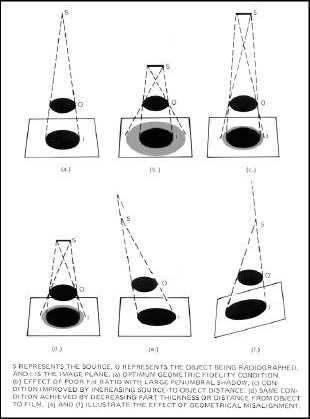T.O. 33B-1-1
6-53
degree of distortion. Alignment is particularly critical for crack detection. Since discontinuities revealed in
radiographic images are usually identified by their shape, images free of distortion are very important in radiographic
interpretation. Where complex structures are encountered in aircraft inspection, it is often impossible to locate the
parts in the most desirable position, and sometimes inspection is facilitated by planned distortions. Interpretation of
distorted images is not impossible, but the film reader needs to visualize mentally the geometry of exposure and
substitute visualization of the distorted image with the projection of the image by the radiation source. This ability
requires practice and experience.
6.7.2.5
Image Unsharpness.
Image unsharpness is the term usually applied recognizing the fact that there is always unsharpness to some degree and
that perfect image sharpness is unattainable. The amount of geometric image unsharpness is due to size of the source
of radiation and relative distances as shown in Figure 6-23. The distance on the film over which an edge is spread is
known as the penumbral shadow or the geometrical unsharpness, U
g
. The value of U
g
does not enter into other
computations; it sets the upper limit for Ft/d. The value must be determined experimentally. The equation to
determine unsharpness is:
Figure 6-23. Possible Geometric Distortions.
Ug
= Ft/d
where:
F
=
maximum dimension of the focal spot
t
=
distance from the source side of the test object to the film
d
=
distance from the source to object
6.7.2.5.1
In considering geometrical unsharpness, recognize the value of new microfocus X-ray sources and the potential for
geometric magnification. Figure 6-24 is a nomogram to assist in solving this equation for various geometrical


